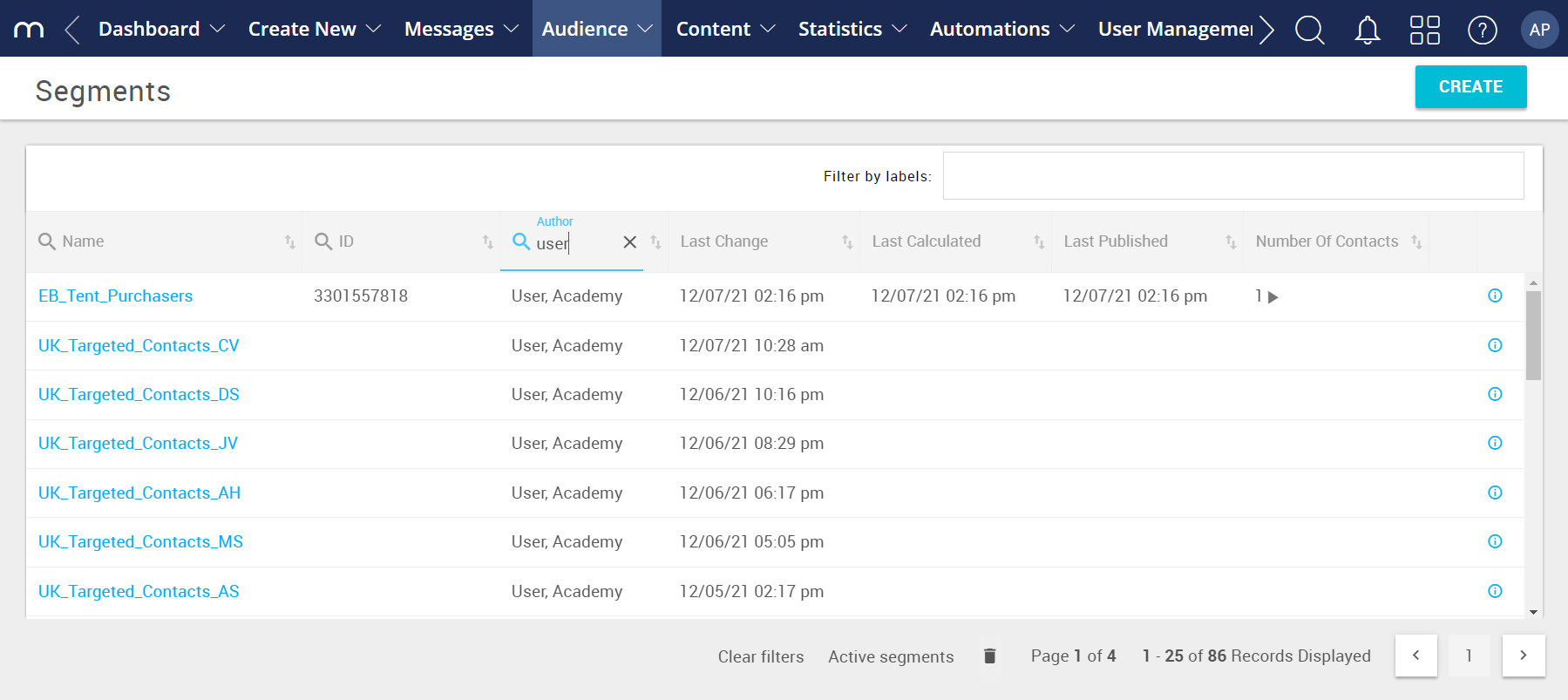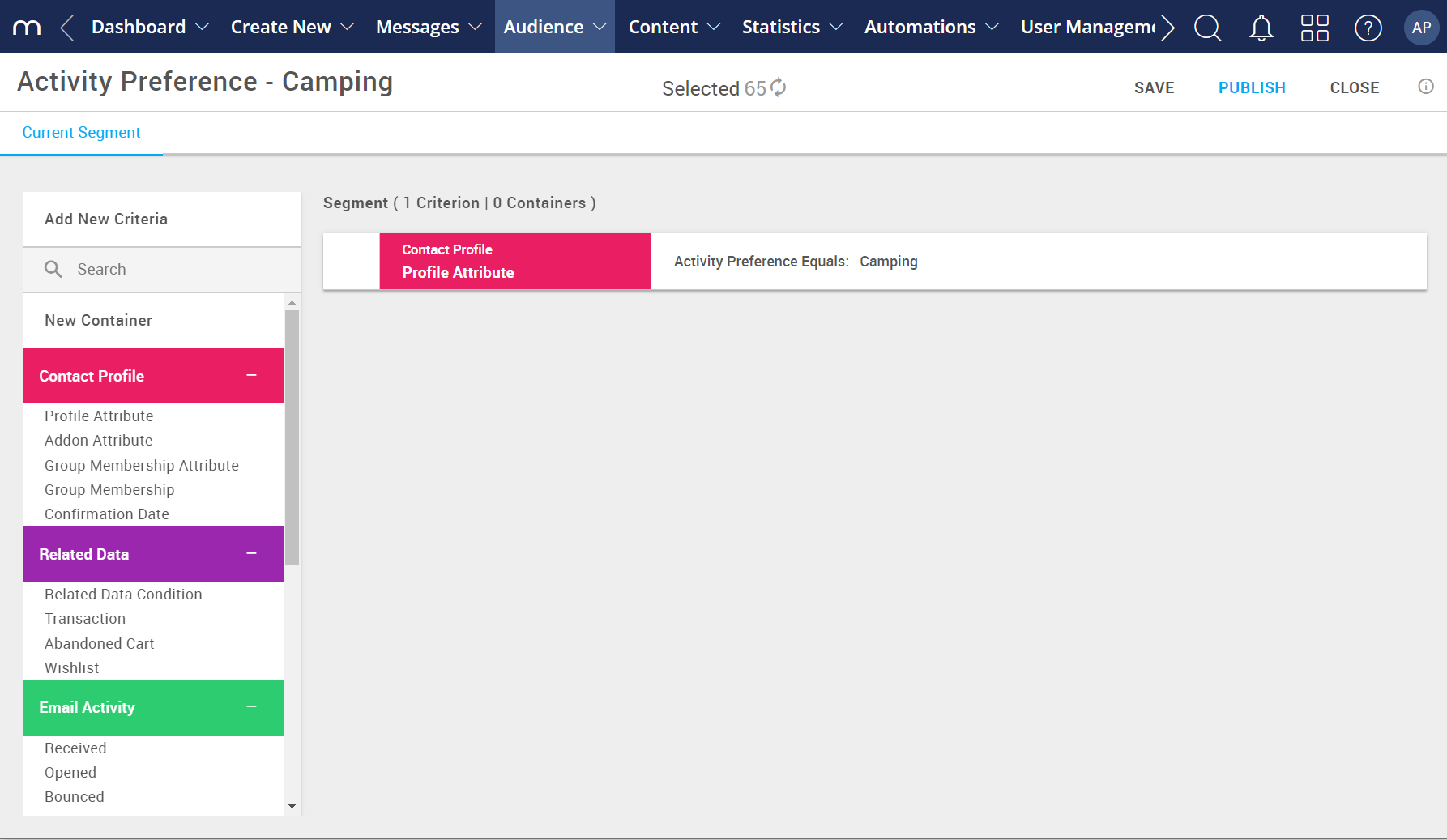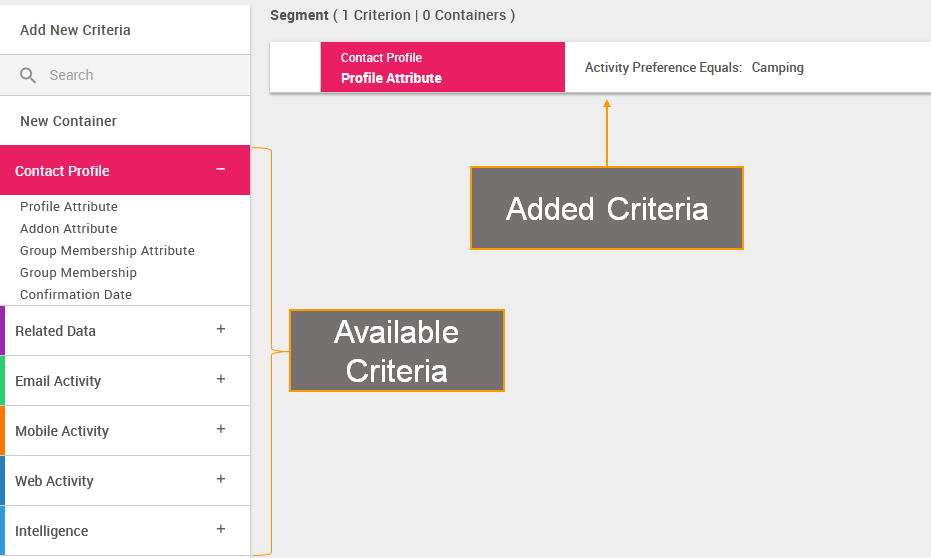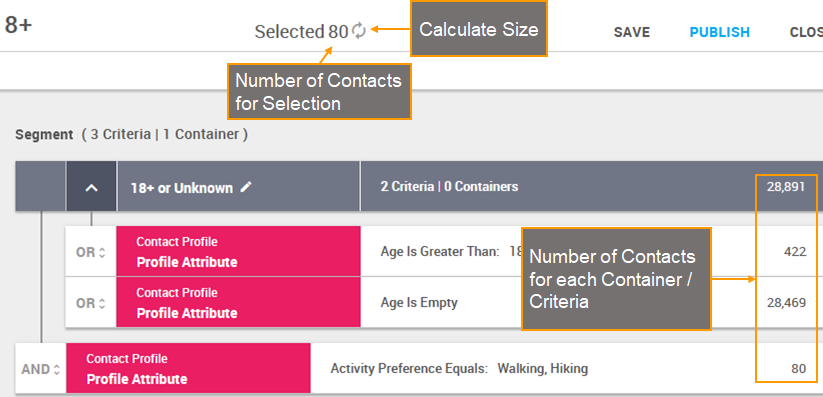Basics
A segment is a structured list of criteria that filters contacts in Mapp Engage. This article contains all the basic information about segments in Mapp's Segmentation Builder.
Overview
The main page of the Segmentation Builder area shows a list of all your saved segments.

Navigation path
Audience > Segmentation > Segmentation Builder
What can I do in this window?
Create a segment.
View, copy, and edit existing segments.
Delete or archive segments that you no longer use.
Field | Description |
|---|---|
Name | The unique name of the segment. |
ID | The segment ID. The ID is automatically created once the segment is published. |
Author | The system user who created the segment. |
| Last Change | Date and time when the segment was last changed. |
| Last Calculated | Date and time when the segment was last calculated. |
Last Published | Date and time when the segment was published. |
| Number of Contacts | Displays the following information:
|
Information | Click the
|
Basic actions you can perform in the main view are Create and Delete.
Action | Description |
|---|---|
Create | Creates a segment. A window opens where you can define the name and description. |
Delete | Trash can icon at the bottom of the page. Allows you to perform a mass deletion of segments. For more information, see Delete Segments. |
To access more actions from this view, click the record in the list. The actions menu More appears on top of the list. Some actions are only available for records that have a certain status (for example, active or inactive).
| Action | Description |
|---|---|
Edit | Opens the segment in edit mode. You can edit a segment even if it is already published. |
View | Opens a segment in view mode. In view mode, you cannot change the segment. |
Copy | Makes a copy of the segment. The copy has the same structure and criteria as the original.
When you create a copy, you must change the name of the segment, since each segment must have a unique name.
|
| Calculate | Calculates how many contacts currently meet the segment criteria. |
Delete | Deletes the segment after a confirmation prompt. You cannot restore a deleted segment. If the segment is already in use in Mapp Engage, the automation or sendout executes as planned. The delete action does not affect the automation or sendout. |
| Transfer | Allows you to add the segment to a group. For more information, see Add Segment to a Group. |
| Archive | Allows you to archive segment you no longer use. For more information, see Archive Segments. |
Configuration

Navigation path:
Audience > Segmentation > Segmentation Builder > Create
What can I do in this window?
Create a segment.
Configure the criteria settings in the settings panel.
Add or remove criteria and containers to the segment.
See how many contacts are in your segment and in each criterion.
Working in Segmentation Builder
The Segmentation Builder allows you to filter your contacts based on their behavior and attributes saved in Engage.
| Actions | Description |
|---|---|
| Add a criterion | Double-click the criterion in the Add New Criteria panel on the left. You can also drag and drop criteria. |
| Add a container | Double-click New Container in the Add New Criteria panel on the left. You can also drag and drop the element. |
| Search for criteria | Enter the first few letters of the criterion name in the |
| Rearrange the criteria | Drag and drop them in a new location. |
| Calculate segment size | Click the |
Open Context Menu | Mouse-over the criteria to display the
|
Operators
When you create a segment with multiple criteria, you combine the criteria with logical operators.
AND | The contact must match all the criteria on the level or in the container. |
OR | The contact must match one or more of the criteria on the level or in the container. |
To change the operator, click the operator on the canvas. A menu opens where you can select a different operator.
When you create a segment with multiple criteria, you combine the criteria with logical operators.
Containers
In Segmentation Builder, you create complex segments with visual containers. A container functions like a set of parentheses in a mathematical expression. With containers, you can create segments that combine both AND and OR operators in a single segment.

Example:
- Select contacts who live in London OR drive a certain car.
- The car is expensive AND has a certain colour.
- The colour is red OR blue.
- London OR (expensive AND (red OR blue)).
To add a container to the canvas, double-click New Container in the Add New Criteria panel. You can also drag and drop a container onto the canvas.
- A container holds one or more criteria that are combined with the same operator.
- Drag a container from the Add New Criteria panel onto the canvas. To create nested criteria, drag a container beneath and to the right of another criterion.
You can import an existing segment into a container of a new segment. At this point, the imported segment is not connected to its source anymore, and any edits you make to it, do not affect the source. By the same token, any changes made to the source segment, will not affect the imported one. For more information, see Import Segment to Segment. You can add up to four levels of containers.
All conditions on the same level or in the same container must have the same operator. If you change one operator on a level, the operators for all other conditions on the same level change at the same time.
Once you have added criteria to a container, you can move the whole container to a different level or position in the segment. A container lets you move multiple criteria at once.
You want to select contacts who are active members of the main newsletter group (NewsletterGroup) and who live anywhere in the Northwest region (postcodes 12345, 12346, and 12347). To create this segment, add the postcode criteria to a container named "Northwest Region."
AND NewsletterGroup = Active Members
AND Container "Northwest Region"
OR Postcode = 12345
OR Postcode = 12346
OR Postcode = 12347
This arrangement is equivalent to the following expression:
(NewsletterGroup = Active Members AND (Postcode = 12345 OR Postcode = 12346 OR Postcode = 12347))
Contact Counts
While you work on the Segmentation Builder canvas, you can monitor the number of contacts in your segment. These counts provide instant feedback about the size of your segment and help you to evaluate the projected impact of your campaign.
You see this information while you are building the segment, so you can check and adjust the segmentation criteria as you work.

As you work in the Segmentation Builder, you see three numbers:
The total number of contacts in the whole platform who meet all the segment criteria. This number appears at the top of the segment.
This calculation is not done automatically - you must trigger it manually by clicking the icon at the top of the canvas.
icon at the top of the canvas.
- The maximum size set for the segment. This number appears at the top of the segment. To see how to set the maximum segment size, see Limit Segment Size.
The number of contacts who match the filter criteria of a container. This number appears at the top right of each container.
The subset of contacts who match single filter criteria. This number appears on the right side of each criterion.
Note that for criteria that contain more than a milion records, calculating this value is disabled by default. This is to avoid potenential timeout caused by the system processing heavy data sets.
Example

- The overall segment size is displayed at the top right of the container.
- One of the Related Data Conditions in the container above has more than a milion records. The fastcount option is disabled and the symbol
 is displayed instead od the caclulated number. Hovering over the symbol shows a tooltip with the relevant information.
is displayed instead od the caclulated number. Hovering over the symbol shows a tooltip with the relevant information. - The sizes of the two remaining Related Data Conditions within the container are calculated and displayed because they contain less than a million records - in our example, 50, and 5000.
Available Segment Criteria
The articles listed below, explain details about the segment criteria available in the Segmentation Builder.

